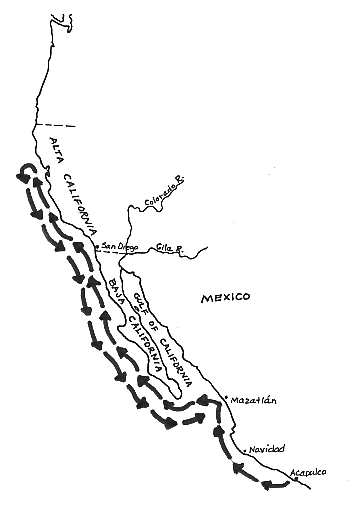| ||||
|
| ||||
|
SEBASTIAN
VIZCAINO
 Lived:
from about 1548 to about 1629
Lived:
from about 1548 to about 1629
Explored California in: 1602-1603
Exploring for: Spain
Explored: by sea along the California coast
To Vizcaíno, a Spanish merchant-adventurer, we owe the names of many places along the California coast.
EARLY HISTORY
Sebastián Vizcaíno was a Basque
(a people who lived in the Pyrenees Mountains of
BACKGROUND
Seeing a chance to make more
money, Vizcaíno made several trips between New Spain and Manila in the
Vizcaíno also tried to establish a pearl fishery and a settlement in Baja (Lower) California. He abandoned that project when fire destroyed the camp.
The Viceroy of New Spain at this
time was Gaspar de Zúñiga y Azevedo, Count Monterey. He persuaded Vizcaíno
to take command of an expedition up the coast of California. This expedition
was ordered by King Philip III of
VIZCAINO’S JOURNEY
Vizcaíno sailed from Acapulco, on the coast of New Spain, on May 5, 1602, with about 200 people and three small ships: the San Diego, the Santa Tomás, and a launch (the Tres Reyes). Besides sailors and soldiers there were six navigators, a mapmaker, three priests, and Vizcaíno’s 13-year-old son, Juan. The chief navigator was Francisco de Bolanos who had been with Cermeño on the San Agustín when it went down off Drake’s Bay in 1595.
The expedition stopped at many places that had been visited in 1542 by Juan Rodríguez Cabrillo. They took soundings of the depths of the water and charted the outline of the land. Vizcaíno gave these places new names.
The first stop in Alta (Upper) California was the harbor of San Miguel, which Vizcaíno renamed San Diego Bay. He chose this name because he was anchored there on November 12, the feast day of St. Didacus of Alcalá. They stayed at San Diego for about ten days, enjoying the fresh sea food and other food given to them by the Indians.
Continuing northward, Vizcaíno
named Santa Catalina Island, San Pedro, Santa Barbara, Point Conception, the
On December 16, 1602, Vizcaíno sailed into a broad bay. He named it El Puerto de Monterey, in honor of Count Monterey who had sent him on this journey. Vizcaíno’s report of this bay was glowing. He said that it was “sheltered from all winds” and would make a perfect harbor for the Manila galleons. In truth, the bay at Monterey offered no protection at all. Vizcaíno’s description was so misleading that later explorers did not recognize the bay as Monterey when they came to it.
Because many of his crew were sick, Vizcaíno sent one ship, the Santa Tomás, back to New Spain. Of the 34 men on board, only nine were alive when it reached Acapulco. The other two ships continued sailing north along the coast as far as Cape Mendocino. There they were separated by a storm, and each made its way back to Acapulco alone. As other explorers before him, Vizcaíno sailed past the Golden Gate and San Francisco Bay without seeing it.
By now many more men were sick from scurvy and starvation. More men died, and those alive could scarcely stand, they were so weak. They were afraid to anchor anywhere, for they did not have the strength to pull up the anchor again. Only about half of those who set out on this journey were alive at its end.
Vizcaíno may have made Monterey Bay sound better than it was because he knew the Spanish government wanted to find a good harbor. Vizcaíno wanted to get that reward of the command of a Manila galleon, and thought a good report would give him a better chance.
Count Monterey was pleased with Vizcaíno, and listened to his ideas of founding a settlement at Monterey. However, the Count was replaced as Viceroy in 1603 by the Marqués de Montesclaros, who did not like Vizcaíno and refused to give him command of the Manila galleon, as he had been promised. The Marqués accused the expedition’s mapmaker, Martínez Palacios, of forgery and had him hanged.
The King of Spain directed the Marqués to put Vizcaíno in charge of a settlement at Monterey, but the Marqués found reasons not to do it. Captains of the Manila galleons were told not to stop at Monterey Bay.
WHAT HE ACCOMPLISHED
The reports of the California coastline and the maps that were made by Vizcaíno’s expedition were used many years later by other explorers. Vizcaíno is remembered because the names he gave places along the coast are the ones used today. He is also remembered because of his inaccurate description of Monterey Bay which misled later explorers.
Father Antonio de la Ascensión kept records of the voyage. His descriptions of the animal life and land were accurate. He praised the beauty of the land and the richness of its resources.
LATER YEARS
Vizcaíno left New Spain after this voyage. In 1611 he became an envoy (messenger on an official mission) for the King of Spain, sent to look for several rich islands reported to be near Japan. The islands were not to be found. Vizcaíno then explored and mapped the coast of Japan. It is said that he returned to California in 1614 with 180 Japanese “tourists” bound for New Spain. He died in Mexico in about 1629.